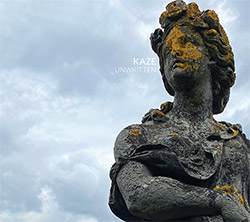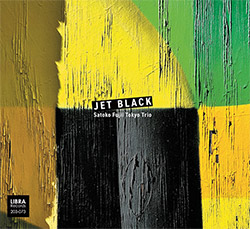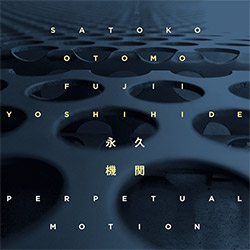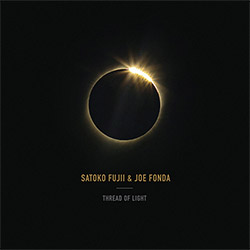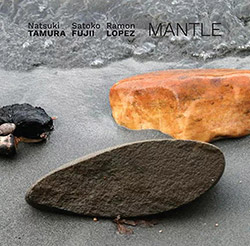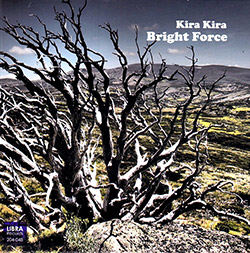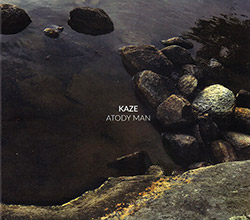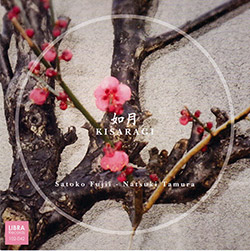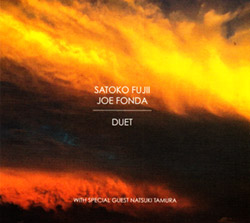
A stunning sound collage made from recorded fragments of Fujii's studio piano, captured inside and out using traditional piano sonorities and preparations that often microscopically detail the instrument, then edited into two electroacoustic compositions of startling and unexpected expansiveness and wonder; a unique and fascinating release in Fujii's large oeuvre.
In Stock
Quantity in Basket: None
Log In to use our Wish List
Shipping Weight: 2.00 units
Sample The Album:
Satoko Fujii-piano, editing
Click an artist name above to see in-stock items for that artist.
UPC: 456162308678
Label: Libra
Catalog ID: 201-067
Squidco Product Code: 30994
Format: CD
Condition: New
Released: 2021
Country: Japan
Packaging: Cardboard Gatefold
Recorded at the artist's home in Kobe city, Japan, in March, 2021.
"Pianist-composer Satoko Fujii is often quoted as saying that she "wants to make music no one has heard before." She more than fulfills that goal on her latest solo album, Piano Music. Using short pre-recorded snippets of her prepared piano music, she edits them together to create a patchwork quilt of unique sonorities. The results are unlike anything she has done before-two extended pieces of otherworldly piano sounds and melodies that evolve so smoothly and organically you can't tell they're stitched together from smaller fragments.
"I started recording in my small piano room during the pandemic and while I was editing the recordings, I got this idea," Fujii explains. "I thought I could put together small parts to make a big work, fitting the pieces together the way I wanted to. I could make music like building with Legos. This may not be a new thing for many creators, but for me it was new because I am a very analog piano player.
"To create my 'Legos,' I recorded short improvisations using one idea for each, like 'plucking strings,' 'Ebow on high strings,' 'rubbing low strings with a big felt mallet,' or 'dropping chop sticks on the piano strings.' Each was less than one or two minutes," she continues. "The materials I recorded are all so short that without shifting them around, they don't make any sense. "Then I transferred these parts into my music editing application. Putting together the small parts into a larger picture was just like improvising," she continues. "I would play a section and most of the time without pausing, I would just drag the next part that I wanted to follow it. I could spontaneously make the longer piece in real time. I learned a lot musically with this process because I found I have a tendency to change the scene too quickly. I kept telling myself, 'Take your time. Take your time.'"
In fact, the opening track, "Shiroku" (meaning "white" in Japanese), does take its time unfolding. Sustained drones are the sonic thread that connects sequences of tones and sounds, each one lovely and strange, like a necklace of pearls. Each richly textured note, high crinkling sound, soft wave of white noise, and rhythmic tinkling is beautiful, but the logic and order behind their occurrence remains elusive, even though you sense it is there. It's like observing a mysterious natural process.
"Fuwarito" (which means "softly and lightly") organizes itself around wave patterns that swell and recede rather than sustained drones, and the phrases are shorter and more rhythmic. She creates a swirling cloud of sounds with sparkling tones, woody rattles, and metallic plucks dissolving within it.
"I would like to be free in the music to do whatever I want and I made this music in a way I have never done before," Fujii says. "Of course, I love playing piano, but I think it's not the only way for me to make music."
Critics and fans alike hail pianist and composer Satoko Fujii as one of the most original voices in jazz today. "Across all of Fujii's work, contradictions come into balance; though her music is abstract and sometimes wild, each element shimmers with clarity," writes Giovanni Russonello in his New York Times feature article. "In situations large and small, her tender attention to detail is equaled by her ability to convey enormous breadth and textural range."
In concert and nearly 100 albums as a leader or co-leader, she synthesizes jazz, contemporary classical, avant-rock, and folk musics into an innovative style instantly recognizable as hers alone. A prolific band leader and recording artist, she celebrated her 60th birthday in 2018 by releasing one album a month from bands old and new, from solo to large ensemble. Franz A. Matzner in All About Jazz likened the twelve albums to "an ecosystem of independently thriving organisms linked by the shared soil of Fujii's artistic heritage and shaped by the forces of her creativity."
Over the years, Fujii has led some of the most consistently creative ensembles in modern improvised music, including her trio with bassist Mark Dresser and drummer Jim Black and an electrifying avant-rock quartet featuring drummer Tatsuya Yoshida of The Ruins. Her ongoing duet project with husband Natsuki Tamura released their eighth recording, Keshin, earlier this year. "The duo's commitment to producing new sounds based on fresh ideas is second only to their musicianship," says Karl Ackermann in All About Jazz.
As the leader of no less than five orchestras in the U.S., Germany, and Japan, Fujii has also established herself as one of the world's leading composers for large jazz ensembles, leading Cadence magazine to call her, "the Ellington of free jazz."-Libra

The Squid's Ear!
Artist Biographies
• Show Bio for Satoko Fujii "Born on October 9, 1958 in Tokyo, Japan, Fujii began playing piano at four and received classical training until twenty, when she turned to jazz. From 1985-87, she studied at Boston's Berklee College of Music, where her teachers included Herb Pomeroy and Bill Pierce. She returned to Japan for six years before returning to the US to study at the New England Conservatory in Boston, where her teachers included George Russell, Cecil McBee, and Paul Bley, who appeared on her debut CD Something About Water (Libra, 1996). Since then Fujii has been an innovative bandleader and soloist, a tireless seeker of new sounds, and a prolific recording artist in ensembles ranging from duos to big bands. She has showcased her astonishing range and ability approximately 80 CDs as leader or co-leader. With each new recording or new band, she explores new aspects of her art. Regular collaborations include her New York trio with bassist Mark Dresser and drummer Jim Black, augmented by trumpeter/husband Natsuki Tamura to form the Satoki Fujii Four; her duo with Tamura; the Satoko Fujii Quartet featuring Tatsuya Yoshida of the Japanese avant-rock duo, The Ruins; Orchestra New York, which boasts the cream of New York's contemporary avant garde improvisers, including saxophonists Ellery Eskelin and Tony Malaby, trumpeters Herb Roberton and Steven Bernstein, and trombonist Curtis Hasselbring, among others; Orchestra Tokyo, drawing on that city's best improvisers; Orchestra Nagoya; Orchestra Kobe; the co-operative trio Junk Box with Tamura and percussionist John Hollenbeck; ma-do, a quartet including Tamura on trumpet, bassist Norikatsu Koreyasu, and Akira Horikoshi; the Min-Yoh Ensemble with Tamura, trombonist Hasselbring, and accordionist Andrea Parkins; the Satoko Fujii New Trio, featuring bassist Todd Nicholson and drummer Takashi Itani― plus countless engagements and collaborations with some of the world's most important improvisers." ^ Hide Bio for Satoko Fujii
5/1/2024
Have a better biography or biography source? Please Contact Us so that we can update this biography.
Track Listing:
1. Shiroku 18:59
2. Fuwarito 27:01
Improvised Music
Electro-Acoustic
Electroacoustic Composition
Organized Sound and Sample Based Music
Satoko Fujii & Natsuki Tamura's Libra Label
Solo Artist Recordings
Staff Picks & Recommended Items
New in Experimental & Electronic Music
Search for other titles on the label:
Libra.

